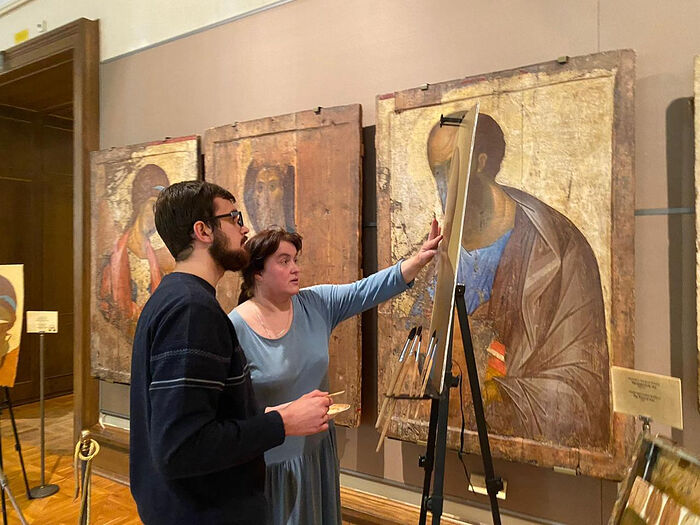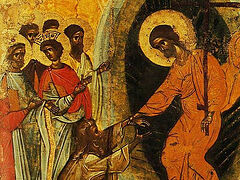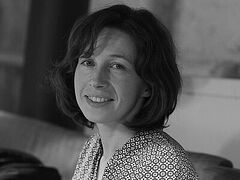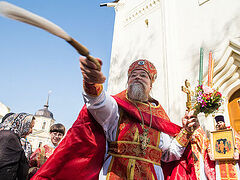How are iconographies of the New Martyrs created, and is portrait likeness important here? Why are Red Army soldiers painted in umber green and flat on these icons? What did Archimandrite John (Krestiankin) say about the creation of an iconographic image? Why do the basics of academic education matter to an iconographer? We talked about this and much else with iconographer Maria Olegovna Glebova, a teacher at the Department of Iconography of St. Tikhon’s Orthodox University of the Humanities.
Maria Glebova, her mother Emilia Glebova, sister Anna Glebova and Maria’s alumni and students are currently displaying their work at the “Conversation about Tradition” exhibition at the exhibition hall of the Moscow Union of Artists (5 Starosadsky Lane, Moscow, January 21–27, 2023).
—Please tell us about your acquaintance with icons.
—My first encounter with icons was in childhood. My mother Emilia Ivanovna Glebova, a professional graphic artist and a pupil of the famous Eugene Kibrik, tried to introduce my sister, brother and me to creative work from an early age. It can be said that I grew up in an artist’s studio and began to draw from the age of two. Our mother gave us brushes and paints to paint on the walls of a big room. We enjoyed painting all over the large surfaces of the walls, using a stepladder to reach higher. Our mother took us to the Pushkin Museum, the Tretyakov Gallery, introducing us to high culture. She showed us albums of fine art, explaining the artistic meaning of the works. Among the albums were editions with reproductions of icons. We listened to our mother’s explanations about the perfection of lines, the characteristic choice of colors in icons, and their special composition. And the creative work of my mother, who paid special attention to the compositional scheme, prepared me to understand icons.
From the age of seven I went to the Krasnopresnenskaya Children’s Art School, and then to the Moscow Secondary Art School. That school is good because students learn to draw professionally from elementary grades and manage to go through various stages of crafts in one or another aspect of artistic creativity or style. We studied drawing, painting, and sculpture from morning until late in the evening... Classes in art history played a special role; our teacher, Marina Viktorovna Merkulova, believed in God, and she guided us to the idea that the icon is the crown and perfection of fine arts.
She showed us by example how Christian art adopted only the best from everywhere—from high ancient (Egyptian, Syrian etc.) culture. By the time I finished school I realized that I did not want to do realistic art; I was only interested in painting icons, and this coincided with my conversion to the faith. There was even a certain crisis—I felt that I could not find an adequate expression of my aspirations and my faith in the language of academic art, and I had not yet studied a new language.
—Tell us more about how you found faith.
—When I was eight I had a teacher who taught clay modeling. She really believed in me, in my artistic abilities and admired my work. This inspired me greatly. A circle of people would meet at her home to read and discuss the Bible, so I saw the Gospel at her place for the first time. As it turned out later, we had a Gospel at home as well. My mother would read it. I also began to read it, pray in my own words and even go to church, but I thought that it was too early for me to get baptized—although I had wanted to for a long time.
Once, when I was in high school, we went to Pskov for excavations and sketches. At the church a friend of mine met Hieromonk Raphael (Ogorodnikov; 1951–1988). After visiting him in Porkhov, she suggested that I go and talk to this priest who was open to people. After our conversation Fr. Raphael said that I needed to get baptized, but I should first go to Elder John (Krestiankin) in the Pskov-Caves Monastery to get his blessing.
When I first saw Fr. John, an image of a good doctor striving to help suffering people appeared in my mind. He told me when and in honor of which saint I should be baptized, and blessed me to come to Pechory to take Communion immediately after Baptism. I was baptized just before the feast of the Transfiguration by Fr. Raphael and went to Pechory, took Communion for the first time at the Dormition Cathedral of the monastery at the early Liturgy, and in the evening Fr. John was waiting for me for a talk in the reception room of the brothers’ quarters.
His incredible love for people, compassion in their troubles and ardent participation in their lives were imprinted on my memory. After each meeting I felt as if illumined, warmed by an invisible light. I began to visit Fr. John regularly, asking for his advice for my life, showing him my first icons. He explained to me how to paint and how icons should look. He said that it was important to study drawing and painting, to get an art education, giving all your energies to your studies. In a letter he wrote to me that I should have a faithful hand and a heart faithful to Christ—only then could I become a real iconographer. The way I do academic drawing and painting determines whether I can paint icons or not. It was difficult for me (I was going to graduate from the Moscow Secondary Art School) to understand him back then... Drawing still-lifes—those academic things seemed boring to me. I really wanted to paint and draw holy images, which I secretly did. It was not until later that I realized how important it is for an iconographer to be a professional, and now I especially draw my students’ attention to drawing, painting and composition... It cannot be otherwise: you simply won’t be able to paint an icon if you don’t know these disciplines; after all, it is much more than academic art, and therefore it includes such achievements.
 —So, after becoming a church-goer you without hesitation entered the iconography school at the Moscow Theological Academy, true?
—So, after becoming a church-goer you without hesitation entered the iconography school at the Moscow Theological Academy, true?
—Fr. John blessed me to do this. He told me to say at the entrance exam that it was his blessing, that he asked them to admit me...
Studies at the school of iconography at the Holy Trinity-St. Sergius Lavra impressed and inspired me very much. My iconography teacher was a close pupil of Nun Juliana (Sokolova), and the iconographer and restorer Ekaterina Sergeyevna Churakova (1918–2004), a very religious person from a family of creative intellectuals. Her parents had been pupils of Valentin Serov, and the great artist Mikhail Nesterov was a friend of their family and often visited them, showing them his sketches for paintings. She had a large family—seven brothers and two sisters—and all of them painted and then became artists and restorers. In Ekaterina Sergeyevna’s works, which she would show us, could be seen a higher institute of drawing and painting. At the same time, she was a very spiritual and incredibly modest person—this is what an iconographer and a Christian in general should be. She used to say: “We need to learn, looking at ancient icons, to follow the ancient patterns in their authenticity.” Now I say the same to my students.
 Christ the Great High Priest I remember my studies there as the joy of being present at church services, the happiness when at the museum and scrutinizing an ancient icon, studying and carefully copying it, literally plunging into it, so the world around me seemed to disappear.
Christ the Great High Priest I remember my studies there as the joy of being present at church services, the happiness when at the museum and scrutinizing an ancient icon, studying and carefully copying it, literally plunging into it, so the world around me seemed to disappear.
Archimandrite Luke (Golovkov) created a special, amazingly creative and kind atmosphere at the school of iconography. I know that the same atmosphere still reigns there. From his parents’ large family he took the experience of love and care and spread it to the school. His methods of communication with and education of students seem the most correct and effective. The most important thing in them is kindness, the desire to understand students. Education is not about reprimands and strictness, but about good example, prayer, service and patience. I try to follow this to the best of my ability, but it doesn’t always work...
After graduating from the school of iconography I returned to Moscow (with Elder John’s blessing), where teachers of iconography were needed at the newly opened St. Tikhon’s Orthodox Institute (now a university). Fr. John believed that one should have a spiritual father near one’s home, and my friend and I asked him to bless us to be pastored by Archpriest Vladimir Vorobiev, the rector of St. Tikhon’s University. So we became Fr. Vladimir’s spiritual children.
Creation of the iconography of the New Martyrs
 —Tell us about the creation of a new iconography, since you were among those who designed the iconography of the Synaxis of the New Martyrs and Confessors of the Russian Church.
—Tell us about the creation of a new iconography, since you were among those who designed the iconography of the Synaxis of the New Martyrs and Confessors of the Russian Church.
—In 2000, in a run-up to the canonization of the New Martyrs and Confessors at the Jubilee Bishops’ Council of the Russian Orthodox Church, our institute (a team of teachers) was assigned to design the iconography of the New Martyrs and Confessors of Russia.
We were also charged with the task of painting for the canonization half-length icons of the particularly venerated new saints in the dioceses. I was to design an icon of the Hieromartyr Peter (Zverev), and his face was not easy in terms of iconography: a peculiar beard, lush hair, small eyes and a prominent nose—it was simply impossible to find something similar in other iconographies. I would make a lot of sketches a day while praying, but my images were still wrong. Seeing my efforts and problems, my mother advised: “Proceed straight from the portrait, look at the God-given proportions of his face, features and character.” I sat down and heeded my mother’s advice, then drew it, and the image came out convincing. I understood where to start: I should first study the saint’s portrait features and the nature of his face and then translate it into the icon...
—Did your mother’s advice help you when you were working on the icon of the Synaxis of the New Martyrs and Confessors of the Russian Church?
—Yes, it helped a lot. She said that despite the fact that there are many of them on the icon, the saints should not all look alike. True, the general style matters, but the character of each face must also be read. She suggested that at the beginning of work on a saint’s icon I first make sketches from photographs, highlighting the characteristic features. “The photographs are more expressive and spiritual than the images on the icons, which is absolutely wrong,” she told me.
At the beginning of work on the icon of the New Martyrs and Confessors of Russia, I was to decide on the icon’s general composition. We made different sketches and examples of different variations of iconography. Initially, we took as the basis the iconography of the icon, “All Saints Who Shone Forth in the Land of Russia”, painted by Juliana (Sokolova), and then the iconography of the icon, “The Synaxis of All the Venerable Fathers of the Kiev Caves”. The image of the Dormition Cathedral in the Kremlin was first placed in the center of the icon as the major Patriarchal church of the Russian Church. But Metropolitan Juvenaly (Poyarkov) of Krutitsy and Kolomna, who then headed the Synodal Commission for the Canonization of Saints, gave his blessing to depict the Cathedral of Christ the Savior, the martyr-church, in the center.
 It was also decided to make scenes around the sides, placing them from north to south. Many sketches were made; Fr. Vladimir Vorobiev and Archpriest Alexander Saltykov, Dean of the Department of Church Art, chose what events and places should be depicted on this icon: for example, Solovki, Lisya Balka in Shymkent in Kazakhstan, and Khe on the mouth of the Ob River beyond the Arctic Circle where Metropolitan Peter (Polyansky) suffered. Some scenes around the sides with saints were approved, others were not—we wanted to include a lot in this icon! As a result, we decided in favor of the most epoch-making places and events. We worked on the icon for a very long time and even had to work at night.
It was also decided to make scenes around the sides, placing them from north to south. Many sketches were made; Fr. Vladimir Vorobiev and Archpriest Alexander Saltykov, Dean of the Department of Church Art, chose what events and places should be depicted on this icon: for example, Solovki, Lisya Balka in Shymkent in Kazakhstan, and Khe on the mouth of the Ob River beyond the Arctic Circle where Metropolitan Peter (Polyansky) suffered. Some scenes around the sides with saints were approved, others were not—we wanted to include a lot in this icon! As a result, we decided in favor of the most epoch-making places and events. We worked on the icon for a very long time and even had to work at night.
Fr. Vladimir’s and Fr. Alexander’s advice on painting icons of the new hieromartyrs was extremely valuable and helped us very much. For example, for a long time I could not create a proper image of Tsar Nicholas II, although there was a portrait resemblance. Fr. Alexander said that the Tsar is Christ’s personification on earth, and therefore I must look at the iconography of the Savior. In the image of the Savior, the light shading (from the word “ocher”—a gradual transition from the main dark tone of personal painting to lighter ones) often fits into a circle, sun-like, and here I did the same and immediately the image took shape.
Fr. Alexander Saltykov told us that we must look carefully at what type of spiritual service a saint performed, what virtues he acquired and what fruits of the Holy Spirit he had: peace? Longsuffering? Truth? The most important parts of the face are the eyes and the mouth—they should reflect the saint’s main virtues. He explained to us how to achieve this in an icon.
I am also grateful to Fr. Vladimir Vorobiev, who also helped us with his advice.
The iconographer himself should think about how to show the saint’s character accurately, but it is good to consult with competent representatives of the clergy when creating a spiritual image.
—You have painted a number icons of New Martyrs. Tell us about some.
—Relatives and representatives of dioceses repeatedly approached us at the Institute with the requests to elaborate a New Martyr’s iconography. For example, together with a colleague, now Nun Xenia (Ustinova), we designed the icon, “Synaxis of the New Martyrs and Confessors of Kazakhstan.” Keeping in mind the advice to rely on ancient icons, we took the icon, “Sts. Boris and Gleb with Life Scenes” of the second half of the fourteenth century, kept at the Tretyakov Gallery, as a color basis.
In an icon the plastic idea and the rhythm are always important—all this is thought out in advance, along with the choice of colors.
I noticed that whenever I paint an icon of a new martyr, I feel great support and God’s help. In this case, some serious temptations are sure to appear. The New Martyrs endured incredible suffering, and if you paint their icons from the comfort of your peaceful life, albeit with all piety, the Lord sends something that makes you pray harder.
On the other hand, you constantly feel the intercession of the New Martyrs. All significant events in my life have occured on their feast-days.
—In the icon of the Synaxis of the New Martyrs and Confessors of the Russian Church, historical realities are also shown, including images of Red Army men. Why did you decide to depict them like this?
—When we were designing images of the Red Army soldiers who killed the Royal Martyrs, bishops, priests, ordinary laymen, women and children who had not renounced their faith and the Church, we decided to make them umber green—a color usually used in depicting demons. Red Army soldiers are flat figures with pale faces (saints have a totally different face colors). We deliberately separated them as the embodiment of evil spirits. Moreover, before drawing their uniforms, we studied documents, showing what they and their weapons looked like and then stylized them. That is, there is reality here, but it is stylized—these are not concrete people, but a kind of embodiment of evil.
 Priest-Martyr Vasily Nadezhdin —The New Martyrs lived not so long ago. They left behind photographs and sometimes video chronicles, not just written and oral sources. Does it complicate or simplify the work of painting their icons?
Priest-Martyr Vasily Nadezhdin —The New Martyrs lived not so long ago. They left behind photographs and sometimes video chronicles, not just written and oral sources. Does it complicate or simplify the work of painting their icons?
—I would say it makes this work special and unique. For example, I designed the iconography of Priest-Martyr Vasily Nadezhdin. It was an amazing experience. Fr. Vasily died very young in the labor camp—at the age of thirty-five; at the time of his martyrdom he had five small children. By the time I was painting his icon some of his own children and spiritual children were still alive. When I was making sketches, looking for an image, I showed them to his former parishioners and children who still remembered him. They looked carefully and said whether they were similar or not.
Their comments contributed to the creation of his iconography. I corrected the face until I heard: “Now it’s our father’s image.” But they did not just make comments—all of them prayed for me so the saint’s image would be good.
So, whenever a new image is being created, prayer for the iconographer is vital. After all, the creation of a new icon is the Church’s work. An iconographer should remember that he is not the only one who is creating an icon: the Church is doing it.
To be continued…







